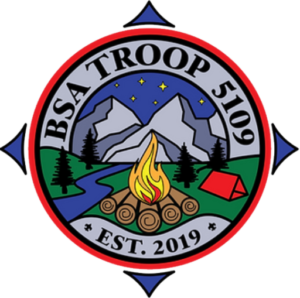A Scout must have permission from the Scoutmaster to begin working on a merit badge and must obtain a signed “Blue Card” from the Scoutmaster prior to commencing work on any specific merit badge. This policy insures that each Scout possesses the basic skills needed prior to embarking on special interest areas. Experience has shown that this method of advancement leads to greater success in the program in the long term and to a stronger connection to scouting in general. A BSA-approved Merit Badge counselor must instruct the Scout in the badge requirements and approve that the Scout has mastered the elements required for earning the badge. The Scout then submits the completed Blue Card to the Advancement Coordinator (an adult troop committee member).
There are over 135 merit badges to choose from and range in topic from athletics, arts, science, robotics, career exploration, and outdoor skills. Scouts may work independently on merit badges, take classes at summer camp, and/or attend merit badge clinics. A blue card can be obtained from the Advancement Coordinator or printed at http://usscouts.org/advance/docs/34124.pdf. After the Blue Card is signed by the Scoutmaster or ASM as Unit Leader (permission to pursue a merit badge), the next step is to obtain the Merit Badge Pamphlet (booklet) and read it to be sure you understand the requirements that are expected to complete that merit badge. Pamphlets are available for purchase for about $5 at the scout shop (some are also available for digital download on Amazon.com), or you may borrow them from the troop librarian (if we have that pamphlet). You will then need to contact a merit badge counselor. If they accept, the counselor can begin meeting the scout either at meetings or at prearranged locations outside of meetings (always observing YPT ratios) to check off completion of requirements. The scout should retain documentation that supports completion of requirements, such as pictures of a Family Life project, tracking of Personal Fitness activities, etc. and provide that to the merit badge counselor for their review.
The Advancement Coordinator maintains a current list of merit badge counselors. Contact a counselor for guidance and expectations. Remember, when doing a scouting activity, observe the BSA no “one on one” contact rule – and always have another adult present (such as a parent). After completing the merit badge, submit the completed Blue Card to the Advancement Coordinator.
If the Scout is attending a merit badge clinic or workshop, there may be pre-requisites that need to be completed outside of class. If the merit badge is not complete, the counselor should initial for any requirements that were completed, and the Scout should bring the blue card (now known as a “partial”) back to the Advancement Coordinator to be logged in Scoutmaster. The Scout can then contact a troop or local merit badge counselor to complete any remaining requirements.
Completed blue cards should be signed by the unit leader (SM or ASM) and turned into the Advancement Coordinator. The merit badge will be awarded at the next Court of Honor, and the blue card will be returned to the Scout with a pocket certificate for the earned merit badge. The merit badge can then be affixed to the merit badge sash, and the blue card and pocket certificate should be retained by the Scout for future reference or if needed at Board of Review. Note: baseball card pocket sleeves are ideal for keeping these neatly stored in a 3-ring binder.
To achieve the rank of Eagle, a Scout must earn at least 21 merit badges, 13 of which are prescribed by requirement. See the Scout handbook and Scoutbook.com for more information on merit badges and contact information for locally approved counselors.
